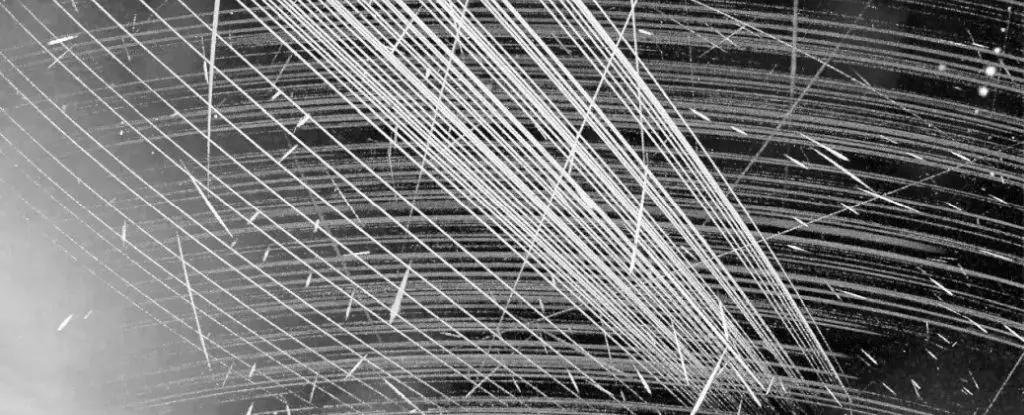As the cosmos becomes populated with more satellite networks, we find ourselves grappling with an escalating dilemma: the rash of radiative emissions from these orbiting entities is infringing upon the precious bands of the electromagnetic spectrum reserved for radio astronomy. Among the myriad of satellite constellations vying for both commercial and research functionality, the second generation of SpaceX’s Starlink satellites—designated as v2mini and v2mini Direct-to-Cell—is emerging as a particularly problematic player. These satellites are reportedly leaking radiation levels up to 32 times greater than their predecessors, creating significant barriers for astronomers seeking to observe the faint celestial signals crucial for understanding our universe.
SpaceX’s burgeoning fleet has ballooned to 6,398 satellites, and with weekly launches of around 40 additional second-generation units, the infrared meteorological landscape is shifting. This growth transcends merely visible streaks across the night sky, which are an eye-catching but superficial detriment; the emissions in specific radio wavelengths penetrate deeper into the core of astronomical research. As noted by Cees Bassa from the Netherlands Institute for Radio Astronomy (ASTRON), the unintended electromagnetic emissions from these satellites surpass the weakest astrophysical signals by a staggering factor of 10 million. This comparison paints a vivid picture of just how overwhelming the interference has become—akin to juxtaposing faint stars against the profound luminosity of a full Moon.
SpaceX is not operating in a vacuum. Other tech giants like OneWeb and Amazon are also launching their satellite initiatives, contributing to a rapidly growing front of low-Earth orbit (LEO) satellites. OneWeb has 634 satellites, while Amazon’s Project Kuiper is poised to introduce over 3,000 satellites, and China’s Spacesail Constellation is eyeing a whopping 15,000. The collective impact of these ventures is a smothering blanket of radio emissions that preempts critical scientific exploration. Beyond the glaring issue of visible light streaks, studies have illustrated the alarming extent of unintended radio frequency interference.
A comprehensive investigation utilizing the LOFAR (LOw Frequency ARray) network showcased significant findings: emissions detected from 97 Starlink satellites in the 110 to 188 MHz frequency spectrum—of paramount importance to radio astronomy—were notably more intense among the newer v2mini models compared to their predecessors. This demonstrates a growing trend where increasing satellite traffic results in amplifying radiative “noise,” effectively drowning out the delicate signals astronomers rely on.
As of now, regulations governing the electromagnetic emissions of satellite constellations are virtually non-existent. The ramifications of this regulatory vacuum are sobering; while the interference from a single satellite might seem minor, the convergence of thousands of satellites poses an existential threat to radio astronomy. The exponential growth of these satellite networks—all competing for a slice of the electromagnetic spectrum—indicates a future where the night sky becomes a cacophony of unintended emissions, jeopardizing essential astronomical operations.
Experts in the field are advocating for immediate regulatory frameworks to address the leakage of radio emissions. Researchers argue, with merit, that satellite operators must tap into their data analytics to isolate the sources of unwanted radiation and implement corrective measures before the situation spirals out of control.
In the words of engineer Federico Di Vruno from the SKA Observatory, humanity stands at a critical juncture where urgent steps must be taken to maintain the integrity of our night skies. With satellite companies largely indifferent to the radiative byproducts of their operations, minimizing these emissions should not only be a priority for their sustainability practices but a moral obligation to preserve the scientific realm they affect. Starlink’s stature in this rapidly evolving satellite landscape gives it a unique opportunity to set industry standards and safeguard the frequencies vital for scientific advancement.
The implications of distorted radio astronomy extend beyond academic curiosity; they encompass a vast array of technological innovations, from global positioning systems (GPS) to Wi-Fi and even medical imaging technologies. The unraveling of our ability to observe the universe could precipitate ripple effects that disenfranchise our future endeavors in technology and exploration. As Jessica Dempsey, ASTRON’s scientific director, noted, the collaboration of regulators and industries is paramount in navigating this intricate landscape.
As corporate ambitions soar into the skies, it becomes incumbent upon regulators, companies, and scientists alike to ensure that we maintain a clear line of sight into the cosmos—one that remains untarnished by the emissions of our own creations. The stakes are high, and time, as ever, is of the essence.


Leave a Reply